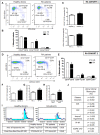Molecular Characterization of Monocyte Subsets Reveals Specific and Distinctive Molecular Signatures Associated With Cardiovascular Disease in Rheumatoid Arthritis
- PMID: 31169830
- PMCID: PMC6536567
- DOI: 10.3389/fimmu.2019.01111
Molecular Characterization of Monocyte Subsets Reveals Specific and Distinctive Molecular Signatures Associated With Cardiovascular Disease in Rheumatoid Arthritis
Abstract
Objectives: This study, developed within the Innovative Medicines Initiative Joint Undertaking project PRECISESADS framework, aimed at functionally characterize the monocyte subsets in RA patients, and analyze their involvement in the increased CV risk associated with RA. Methods: The frequencies of monocyte subpopulations in the peripheral blood of 140 RA patients and 145 healthy donors (HDs) included in the PRECISESADS study were determined by flow cytometry. A second cohort of 50 RA patients and 30 HDs was included, of which CD14+ and CD16+ monocyte subpopulations were isolated using immuno-magnetic selection. Their transcriptomic profiles (mRNA and microRNA), proinflammatory patterns and activated pathways were evaluated and related to clinical features and CV risk. Mechanistic in vitro analyses were further performed. Results: CD14++CD16+ intermediate monocytes were extended in both cohorts of RA patients. Their increased frequency was associated with the positivity for autoantibodies, disease duration, inflammation, endothelial dysfunction and the presence of atheroma plaques, as well as with the CV risk score. CD14+ and CD16+ monocyte subsets showed distinctive and specific mRNA and microRNA profiles, along with specific intracellular signaling activation, indicating different functionalities. Moreover, that specific molecular profiles were interrelated and associated to atherosclerosis development and increased CV risk in RA patients. In vitro, RA serum promoted differentiation of CD14+CD16- to CD14++CD16+ monocytes. Co-culture with RA-isolated monocyte subsets induced differential activation of endothelial cells. Conclusions: Our overall data suggest that the generation of inflammatory monocytes is associated to the autoimmune/inflammatory response that mediates RA. These monocyte subsets, -which display specific and distinctive molecular signatures- might promote endothelial dysfunction and in turn, the progression of atherosclerosis through a finely regulated process driving CVD development in RA.
Keywords: cardiovascular disease; gene profile; microRNAs; monocyte subsets; rheumatoid arthritis.
Figures









Similar articles
-
Overexpression of TLR2 and TLR9 on monocyte subsets of active rheumatoid arthritis patients contributes to enhance responsiveness to TLR agonists.Arthritis Res Ther. 2016 Jan 13;18:10. doi: 10.1186/s13075-015-0901-1. Arthritis Res Ther. 2016. PMID: 26759164 Free PMC article.
-
Blood monocyte subsets and selected cardiovascular risk markers in rheumatoid arthritis of short duration in relation to disease activity.Biomed Res Int. 2014;2014:736853. doi: 10.1155/2014/736853. Epub 2014 Jul 14. Biomed Res Int. 2014. PMID: 25126574 Free PMC article.
-
The CD14(bright) CD16+ monocyte subset is expanded in rheumatoid arthritis and promotes expansion of the Th17 cell population.Arthritis Rheum. 2012 Mar;64(3):671-7. doi: 10.1002/art.33418. Arthritis Rheum. 2012. PMID: 22006178
-
The Role of Different Monocyte Subsets in the Pathogenesis of Atherosclerosis and Acute Coronary Syndromes.Scand J Immunol. 2015 Sep;82(3):163-73. doi: 10.1111/sji.12314. Scand J Immunol. 2015. PMID: 25997925 Review.
-
Monocytes in rheumatoid arthritis: Circulating precursors of macrophages and osteoclasts and, their heterogeneity and plasticity role in RA pathogenesis.Int Immunopharmacol. 2018 Dec;65:348-359. doi: 10.1016/j.intimp.2018.10.016. Epub 2018 Oct 23. Int Immunopharmacol. 2018. PMID: 30366278 Review.
Cited by
-
Do biologic therapies reduce aortic inflammation in rheumatoid arthritis patients?Arthritis Res Ther. 2021 Aug 3;23(1):206. doi: 10.1186/s13075-021-02585-w. Arthritis Res Ther. 2021. PMID: 34344436 Free PMC article.
-
Sex-Based Differences in Monocytic Lineage Cells Contribute to More Severe Collagen-Induced Arthritis in Female Rats Compared with Male Rats.Inflammation. 2020 Dec;43(6):2312-2331. doi: 10.1007/s10753-020-01302-0. Inflammation. 2020. PMID: 32857321
-
Prevalence of wound infections and postoperative complications after total elbow arthroplasty for rheumatoid arthritis: A meta-analysis.Int Wound J. 2023 Oct 22;21(2):e14451. doi: 10.1111/iwj.14451. Online ahead of print. Int Wound J. 2023. Retraction in: Int Wound J. 2025 Mar;22(3):e70325. doi: 10.1111/iwj.70325. PMID: 37867410 Free PMC article. Retracted.
-
Nanoparticles targeting monocytes and macrophages as diagnostic and therapeutic tools for autoimmune diseases.Heliyon. 2023 Sep 7;9(9):e19861. doi: 10.1016/j.heliyon.2023.e19861. eCollection 2023 Sep. Heliyon. 2023. PMID: 37810138 Free PMC article. Review.
-
The Transcriptomic Profile of Monocytes from Patients With Sjögren's Syndrome Is Associated With Inflammatory Parameters and Is Mimicked by Circulating Mediators.Front Immunol. 2021 Aug 3;12:701656. doi: 10.3389/fimmu.2021.701656. eCollection 2021. Front Immunol. 2021. PMID: 34413853 Free PMC article.
References
Publication types
MeSH terms
Substances
LinkOut - more resources
Full Text Sources
Medical
Research Materials

